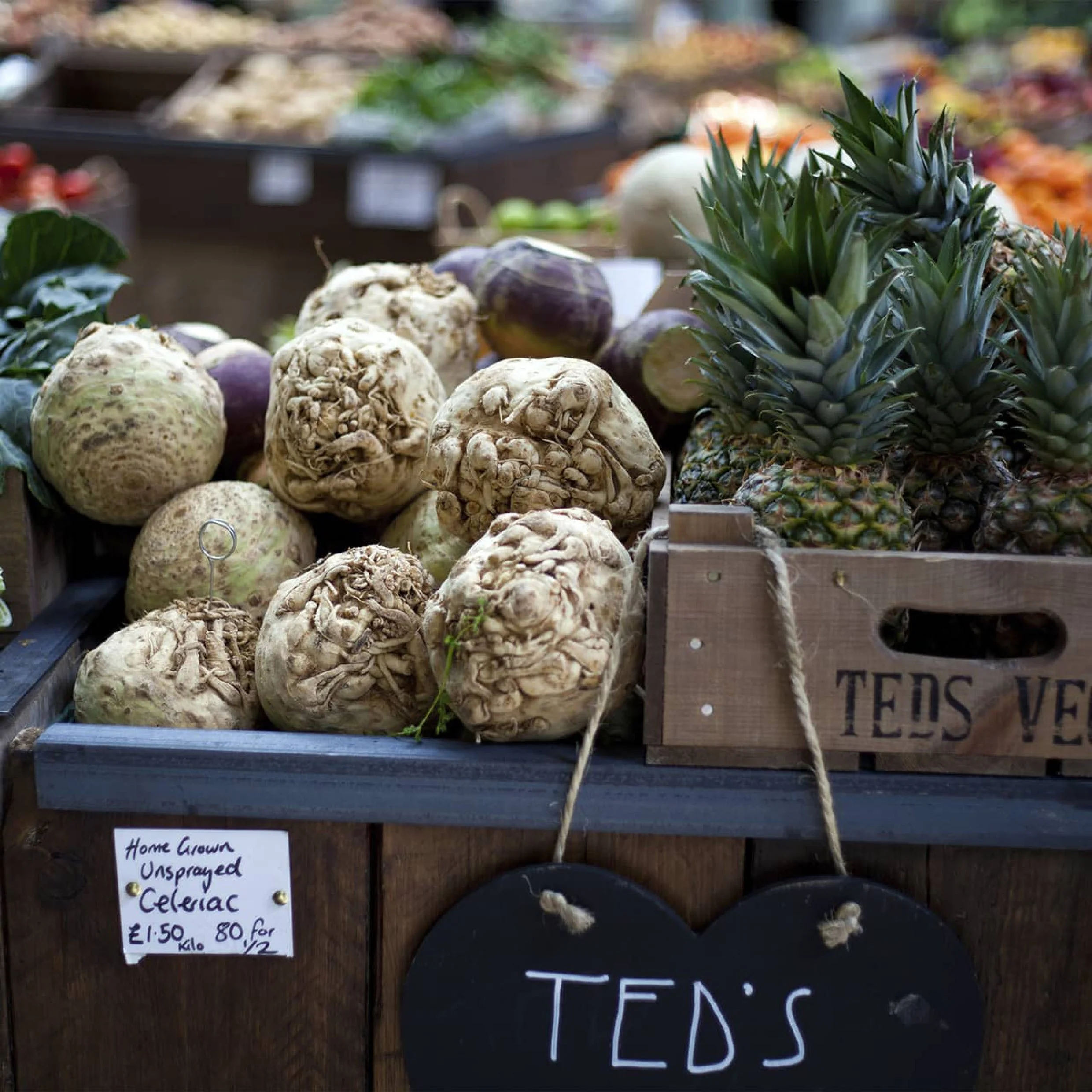Grower's Guide - January - written by Chef Consultant, Celia Brooks
Celeriac - cut it some slack!
Celeriac has a mysterious PR problem. Why is it not better known and loved in the English-speaking world? People at the supermarket checkout see me load a large knobbly whitish-green orb onto the conveyor belt and ask me, “what IS that thing?”, launching me into a diatribe of its many delicious uses - and they are probably sorry they asked…
Its tall and slender cousin celery gets all the attention, and yet celery is not nearly as versatile, nutritious or even as interesting. Don’t get me wrong – I love celery. But for me, celeriac is the real star. Celeriac is the root base of a plant closely related to celery, and only the root is eaten, as the stems are tough and dark green, so they are always cut off (normal celery plants don’t form a root bulb). Some food writers describe celeriac as “ugly”, and while it is a bit of a beast of a vegetable, weighing up to a kilo and about the size of a small child’s head, all I can see is its beauty. It’s all warts and scraggles on the outside, but beneath its less than glamorous exterior is a covetable creamy white globe with endless possibilities.
Celeriac is low in calories and low in carbs, but it performs like a starchy vegetable and can be pureed, roasted and fried. It imparts a wonderful rich dimension to vegetable broth. It can also be eaten raw. Anything you can do with a carrot, you can do with celeriac. It has a unique flavour, similar to celery but with a pronounced sweetness. Coming in such a prolific size, it’s economical too. I think it deserves more love in everyone’s kitchen and diet.
What’s more, it has nutritional superpowers. It’s a fantastic source of vitamin K, for bone and brain health. It’s got antioxidants for fighting cancer, phosphorus for healthy cell metabolism, and a host of B-vits for converting food into fuel.
Here are just a few fabulous and simple ways to use celeriac:
Celeriac mash: The best mash is made 50:50 celeriac to floury potatoes, both in chunks boiled together in well-salted water, drained thoroughly and mashed with milk and butter. It’s also superb with sweet potatoes as a mash.
Celeriac latkes: Use 50:50 grated celeriac and potatoes in your traditional latke recipe for a surprisingly delicate variation.
Celeriac remoulade: Make the classic French side salad with julienne or grated raw celeriac dressed first with a squeeze of lemon juice, then with a good mayonnaise or crème fraiche or half of each, a heavy dose of Dijon mustard, and capers. Serve with a cheese omelette, or use for stuffing a baked potato or sweet potato.
Celeriac and Cashew Cream Lasagne
From “SuperVeg” by Celia Brooks
The finished article is reminiscent of veggie lasagne, but the only aspect it shares with the original is the tomato sauce. I have been seduced into an obsession with blended cashew nuts as a substitute for dairy cream, so I reworked a celeriac gratin of mine, using the cashew cream in place of cream and Parmesan. I was thrilled with the results. It’s not a diet dish – it’s rich and moreish; and it is packed with protein as well as being 100% plant based.
Serves 4
Gluten free (if tamari is used)
Vegan (if maple syrup is used)
Ingredients
1 large celeriac (750g approx unpeeled weight)
2 handfuls of fresh basil leaves
200g raw cashew nuts
150ml water
2 teaspoons lemon juice
1 tablespoon light soy sauce or tamari
For the tomato sauce:
2 tablespoons extra virgin olive oil + more for greasing casserole dish and drizzling
1 medium onion, finely chopped
2 garlic cloves, finely chopped
2 tablespoons tomato puree / paste
1 x 400g can chopped tomatoes
sea salt and freshly ground black pepper
1 teaspoon red or white wine vinegar
1 teaspoon maple syrup or honey
OPTIONS:
Serve with a leafy green salad dressed in a balsamic vinaigrette
Method
1) Boil the kettle. Place the cashews in a bowl and pour boiling water over them to cover. Leave to cool and keep them submerged until ready to use.
2) Preheat the oven to 200C. Brush the casserole dish generously with oil.
3) Prepare the celeriac. Peel it using a sharp knife and cut away the roots and any muddy deposits, then rinse and pat dry. Cut into about 6 pieces and slice as thinly as possible. (Alternatively use a food processor with a slicing blade or a mandolin – the thinner the better.)
4) Make the tomato sauce. Heat a large saucepan (large enough to stir the celeriac into it) over a medium heat and add the olive oil, then the onions, and cook until they are translucent. Add the garlic and fry until fragrant, about 2 minutes. Add the tomato paste, and cook, stirring constantly, until sticky, about 3 minutes. Add the remaining ingredients and stir well. Bring to the boil, lower to a simmer and cook for about 5 minutes, until slightly thickened. Taste for seasoning.
5) Stir the celeriac into the sauce. Cover the pan and simmer for about 10 minutes, stirring occasionally, until the celeriac starts to tenderize.
6) To make the cashew cream, drain the soaked cashews and place in a blender with the rest of the ingredients. Blend at high speed until completely smooth.
7) Stir half the cashew cream into the tomato-celeriac mixture. Tear in a handful of basil leaves and stir. Transfer to the prepared casserole dish. Pour the remaining cashew cream over the top and smooth the surface. Decorate with whole basil leaves and finish with a light drizzle of olive oil.
8) Bake for 30- 40 minutes, until golden and bubbling. Serve right away.



